Wealth of First Nations (2019)

A higher standard of living for First Nations is a priority for Canadian policy makers. To achieve that goal, it is important to know what works and what doesn't. The Wealth of First Nations provides empirical evidence, based on the achievements of First Nations themselves, about the factors associated with high scores on the Community Well-Being (CWB) Index, which aggregates measures of income, employment, housing, and education for all Canadian communities, including Indian reserves. The overall conclusion is that "making" participation in the Canadian economy—is more effective than "taking"—using political and judicial power to obtain larger transfers from government.
High-scoring First Nations usually have long-term stable leadership. They reward Chief and Council adequately but not excessively. They balance their budgets, pay their bills on time, and avoid deficits. They exercise practical self-determination by using "off ramps" from the Indian Act to collect their own taxes and manage their own lands. All these factors show statistical correlation with higher CWB scores, but reliance on Indian Act government or custom governance does not seem to be a relevant factor.
Some high-scoring First Nations make use of Certificates of Possession, the strongest form of individual property available under the Indian Act. Leasing of band land to generate own-source revenue is also a crucial factor. Whatever the legal mechanisms, high-scoring First Nations take advantage of many different economic opportunities, such as tourism and hospitality, residential and commercial real estate development, and natural resource plays. Each high-scoring First Nation has its own unique profile combining several of these legal, political, and economic factors.
In comparison, transfers achieved by political and judicial activism show little or no association with higher CWB scores. Federal spending on Indigenous people has grown exponentially over the last 70 years, but First Nations' CWB has not improved proportionally to that increase in spending. Rather, the improvement of First Nations' CWB parallels the CWB improvement of other Canadian communities. The Canadian economy, not government spending, appears to be the tide that lifts all boats.
Specific claims have resulted in the transfer of almost $6 billion stemming from disputes over the implementation of treaty or Indian Act provisions, but First Nations that have received these settlements do not show higher CWB scores than those that have not received them. In Saskatchewan, large amounts of land have been added to Indian reserves in the name of treaty land entitlement, based on arguments that reserves were smaller than they should have been. Yet these transfers have had no discernible impact on CWB scores except for a small number of entrepreneurial First Nations that have used their new lands to create urban reserves and enter the business world. Attempts to rectify the past do not produce higher living standards in the present or future.
Legal rights have also been transferred, the most important example being the creation by the courts of the "duty to consult" First Nations before authorizing natural resource development projects on traditional territory. Although confidentiality of these transactions precludes exact statistical analysis, it is clear that some First Nations, such as Fort McKay, have obtained large payments through consultation and have invested the proceeds with great success. However, dozens of First Nations have received little or nothing because political activists have used the duty to consult to block oil and gas pipelines. Consultation can be a powerful tool for First Nations that want to improve their CWB by engaging in the Canadian economy, but it won't realize its full potential until the law is reformed to prevent essential corridor developments from being blocked by small groups of political opponents.
Adam Smith showed in The Wealth of Nations how prosperity arises from making and trading, rather than taking. His findings apply to Canadian First Nations, just as they do to other nations.


